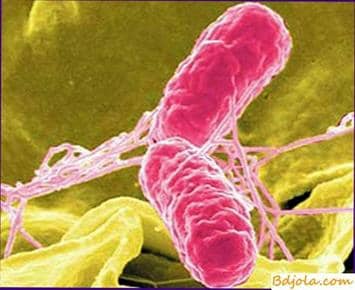
Paratyph – an infectious disease, accompanied by late winter and spring diarrhea and death of adult bees.
The causative agent – Bacterium paratyphi alvei – is a small, polymorphic rod with a rounded ends, 1-2 m long and 0.3-0.5 m wide; the spore does not form, mobile (peritrich), it is well painted with all aniline dyes, gram-negative; facultative anaerobic, grows on all normal nutrient media of a neutral or slightly alkaline reaction, a temperature optimum of growth of 20-39 њ.
On the agar, within a day, the bacterium forms small bluish translucent colonies easily removed by a loop. On the second day, the colonies merge into a general superposition, get a muddy appearance, become sticky. The center of the colony turns brown, and on its surface an elevation is formed in the form of a roller.
The bacterium gives the turbidity of the broth and forms traces of indole in it. On the surface of the broth, a greyish film sometimes appears; gelatin does not liquefy; milk does not roll, it forms brownish-yellow on potatoes, sometimes a gray faint overlay and produces an unpleasant smell reminiscent of the smell of stinking potatoes; on litmus milk a day later forms a slight reddening, later the medium sharply turns blue; decomposes glucose, maltose, arabinose, xylose, rhamnose, mannitol, fructose, galactose and glycerin; does not decompose lactose, sucrose, dulcite, adonite, raffinose, dextrin and inulin. Growth on a medium with Na (NH4) HP04 and citric acid sodium refers to an ammonoacid group; agglutinated only with a specific serum.
The resistance to thermal and chemical influences is weak. Boiling in water kills, the microbe for 1-2 minutes, heating to 58-60 њ – for 30 minutes; a solution of formalin for 6 hours.
Epizootic data. The microbe is pathogenic for bees and wasps; when feeding bacteria in 5-10% sugar syrup causes a high mortality of bees, and when fed in a dense mass of powdered sugar, the bees live about the same as in the controls.
In the spring, after the exhibition of families from winter premises, the paratyph is spread from sick families to healthy ones when the honeycombs are changed, wandering of bees, using a common water bottle.
The course and symptoms of the disease. The incubation period lasts 3-14 days; the mortality rate reaches 50-60%. The disease usually occurs at the end of winter or in spring, and sometimes in summer after cold snap and rain. The development of the disease in winter contributes to poor quality liquid honey and raw premises. Habit more often working bees.
Paratyph has no characteristic external features. Stiffness in the movements of sick bees, paralysis of the wings, weakness and diarrhea are signs that occur in other diseases. The sick bees weaken, crawl with the swollen abdomen at the tap or at the bottom of the hive, lose the ability to fly, diarrhea, easing of respiratory movements, sometimes paralysis of the legs. The disease in acute form proceeds with a large waste of bees. At spring circling, bees emit a lot of fetid, very sticky or semi-liquid feces of dark brown color. Spring flight unfriendly. When inspecting the hives, they usually find sufficient supplies of food, but all honeycombs are stained with excrement in the form of brown sticky or liquid masses. When autopsies are opened, the intestines are swollen and have a dirty white or light gray color.
The diagnosis is based on the isolation of pure cultures and their further bacteriological and serological studies.
Seedings are made aseptically on Endo agar from the intestine and hemolymph of sick bees or from the muscles (breasts) of corpses.
The properties of the isolated microorganisms are studied on ordinary and colored nutrient media.
Prevention. For the winter, bees are left sealed, benign honey. Winterers provide good ventilation in order to avoid high humidity in them. In the autumn and winter, bees can not be disturbed. In the spring put on apiaries drinking bowls with running water.
Control measures. Usually improving the conditions of the bees leads to the cessation of the disease. When bees are killed, they are fed sugar syrup or benign honey with one liter of syrup (honey) added to one of the following antibiotics: synthomycin 0.2 g, levomycetin 0.2 g, streptomycin 200 thousand ED or biomycin 100 thousand units.
Внутренние строение пчелы. Пчела без жала.
Diseases of bees